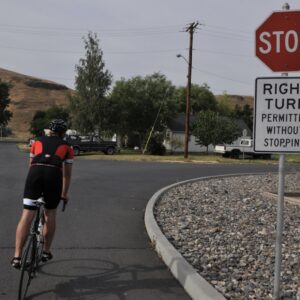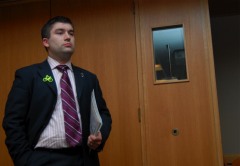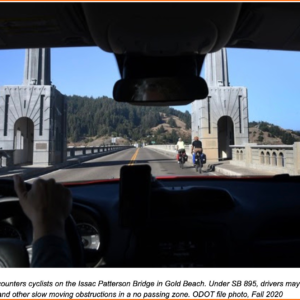
Bicycles and cars are vastly different types of vehicles and our laws should do more to reflect that.
That’s just one of many reasons I strongly support Senate Bill 998 currently working its way through the Oregon Legislature. The bill would allow bicycle users to treat stop signs and flashing red signals as yield signs (also known as “Idaho Stop” for a similar law on the books in Idaho for over 30 years). In other words, you’d only have to come to a complete when it was necessary due to oncoming traffic or some other safety-related condition. The law does not allow dangerous behavior and specifically requires bicycle users to slow to a “safe speed.”
As per usual, this reasonable concept causes many people to freak out. I went on local TV to try and calm some nerves and explain why I support the bill.
This is the third time the idea has come up in Oregon and it feels like there is less freaking out this time around. But with Americans’ deeply embedded sense of driving privilege and related bias against bicycle riders — and a media culture that loves stoking us/them divisions — you can never be sure.
Advertisement
Last week I was invited to the studio of our local ABC-TV affiliate (KATU) to talk about this on their Your Voice, Your Vote public interest show with longtime news anchor Steve Dunn. Just like I did in 2012 when someone wanted to make licenses for cycling mandatory and after Oregon passed a $15 bike tax, I happily accepted the invitation.
In my experience we have much healthier conversations about these sensitive topics the more we get beyond the sensationalism, soundbites, and shouting matches. It would have been nice to debate someone with an opposing viewpoint; but KATU wasn’t able to find anyone who was against the bill and willing to show up. Thankfully, Steve Dunn did a great job asking questions and I think it was a helpful conversation.
Watch the video below and tell me what you think:
As for SB 998, it passed its Senate committee 6-1 and now awaits a committee assignment and vote on the House side. If you support the bill, please contact your representative — especially if your rep is on the House Judiciary committee.
— Jonathan Maus: (503) 706-8804, @jonathan_maus on Twitter and jonathan@bikeportland.org
Never miss a story. Sign-up for the daily BP Headlines email.
BikePortland needs your support.






Thanks for reading.
BikePortland has served this community with independent community journalism since 2005. We rely on subscriptions from readers like you to survive. Your financial support is vital in keeping this valuable resource alive and well.
Please subscribe today to strengthen and expand our work.
Another reason for supporting the law, while I’m moving slowly to observe the safety of progressing through an intersection, I am better able to maneuver out of danger if I’m moving as opposed to stopped.
Well done interview, Jonathan. Near the 14 minute mark in the video, you identify the underlying objection to this law, which is the psychology of opponents who think bicycle users are gaining an advantage not otherwise available to them. This punitive mentality is meant, I think, to bring all of us into some sort of conformance to standards that doesn’t hold up when we talk about what is appropriate for bicycle users, people on foot, and people in cars. Each mode should be treated differently. To the very well articulated, rational reasons why this law should pass, I’d add another. Bicycle users have a much greater field of vision as they move through intersections. That allows us to see where we are going and what is around us and to continue safely. Besides, even when we’re moving “fast,” we rarely move at speeds greater than 15-20 miles per hour.
How much greater?
And what is the marginal difference from that “greater” amount?
If you have to ask, you clearly don’t ride enough.
It’s not a marginal difference… it’s the difference between seeing and not seeing at all. Here’s a real world example that’s happened to me serveral times in just the last year:
I’m approaching an intersection at approx the same speed as a car where I have the right of way and they have a stop sign. Because of the angle and rate we’re both approaching, I’m being obscured by the vehicle’s A pillar (the thick support structure between the windshield and passenger door window). Now if drivers actually stopped at stop signs this wouldn’t be a problem because stopping would allow for me to come into their view. Instead what happens is the driver merely slows for the intersection, thinks it’s clear and proceeds through. At this point, I’ve already started slowing or am prepared to brake.
So yes, it’s true cyclists have a much greater field of view.
And that really is the crux: When driving, people _already are_ behaving according to the Idaho stop law. (Otherwise, as Austin pointed out, a rider would not stay concealed behind an A-pillar.) That is, Idaho stops _already are_ the on-the-ground reality for everyone, motored and non. So any outrage over codifying them comes from someplace ignorant or deceptive.
1000x this. Just about everyone rolls stop signs most of the time. Honestly, I would take all road users yielding rather than stopping if they did so safely and carefully. Slowing when the first 4ft of your car is poking out into the intersection with your foot poised over the accelerator doesn’t count.
If you keep asking the same question, I’m going to keep giving you the same answer.
What is a “Pillar” or A-Pillar”?
https://www.youtube.com/watch?v=ULjSbUYKeZ4
And at this point, cars with A-pillars wide enough to block the view of a pedestrian (thanks largely to airbags and roof strength standards) have been pretty much the norm for over a decade.
Any driver who hasn’t realized this by now – and hasn’t figured out that as they approach a stop sign, they need to move their head back and forth to check around their left A-pillar – has no business driving. Even if you don’t drive a new car, you should have had time to figure this out by now.
Not only see, but hear as well.
Thanks for advocating on the airwaves, Jonathan. I only had time to watch the first 7 minutes of the video, but in what I heard, you sounded very rational and brought up some great points for people to consider regarding operating a bicycle vs an automobile in the urban environment.
I especially appreciate the comparison between right turn on red and the Idaho stop law.
Well done.
Nice! Loved your point about “the other” and the psychology of the resistance to this law.
You sound very reasonable! Thanks for going out there and making the case. If Arkansas can get this passed Oregon should be able to. Contacting my reps now.
I think this is exactly right. As a cyclist, my most vulnerable position is when I’m stopped at a light or a stop sign with one foot clipped into the bike. It’s extremely difficult to unclip and move laterally, and in fact there are a lot of videos of people who get a car or truck turning into their space when stopped in that way. My current MO is to ride my bike either well behind or in front of a car that could possibly turn right, and then do a rolling stop through the intersection so that I am definitely ahead of them as I go through the intersection.
“Must. Pass. Bicycle.”
Yep – ended going round a neighbourhood mini roundabout this morning alongside and outside someone who started coming round me coming up to it, didn’t get past but just dived back in anyway to avoid driving right over the roundabout. Not the first time.
Wow, that was surprisingly unhysterical, unsensational, even-handed coverage.
Many drivers already have a difficult time with bicycles at 4 way stops. Often cars will yield to me and wave me through even though they have the legal right of way. They act as if they don’t expect me to actually stop. Maybe they are just trying to be nice. I fear this law, which I fully support regardless, will exacerbate this issue. Drivers may get the message “bikes don’t have to stop” and sit waiting for us when they see a bicycle approaching. I much prefer they just follow the law and proceed through the intersection when they have the right of way.
The trick is to not look at them. Look down at your front wheel while you come to a stop, and eventually they will proceed.
I find that a properly timed middle finger helps with this issue.
Classy.
Interestingly, I do not find that a well-timed middle finger helps things flow more smoothly.
Really wish you wouldn’t. People waving you on when they should go is a little annoying, and I’d also prefer if people just took their right of way in a predictable fashion, but anyone waving you on is at least somewhat considerate of people on bikes and not deserving of The Finger; they may not remain that way after a couple of Fingers. Proceed and give them a wave?
I don’t like wasting my time. If it is close and they wave me on, I just roll it and go. If they are there well before me and still want to wave me on for some reason, I preemptively wave them on as I am slowing on approach to the sign.
If everyone were riding fixed they would welcome the opportunity to pull a track stand and observe the benighted motorists trying to sort matters out.
Who says you need to be riding fixed? Just point your wheel to the left, which is slightly uphill because roads are crowned (usually). Push a little on the pedals to go a teeny bit uphill, ease up and roll a teeny bit downhill.
Gold star!! Fabulous job.
Loved how you reminded people you’re a driver; that we’re trying to get a lot more people biking; that cars and bicycles are fundamentally different from a physics perspective; and how you worked to dispel the “lawless reckless people blowing through stop signs.”
Really, really sharp.
Thanks for doing that interview, Jonathan, your articulate, well-considered and rational answers on that provided a lot of well-needed color for this. It’s interesting to me when people approach this issue of cars & bikes requiring separate treatment under vehicular law, as if it’s something we need to theorize about and think hard about what “might” happen, when there are so many states and countries where this is already the case. There are so many good examples out there already that prove out your point on bike safety, and what DOES happen when you let cyclists treat signals in this manner.
One of the problems in getting people to understand and support the law change is that lots of people can’t model and visualize the pattern change in their heads. Their brains just don’t work that way. The right of way rules don’t change. Who has to yield to who doesn’t change. But the permission to slow roll a stop sign turns into, “bicycles are blowing through stop signs willy nilly with no regard for anyone.” They can’t see and play through the scenario in their heads.
Another problem is the childish notion that traffic laws have to be the same for everyone, even when they are most definitely NOT already. As Johnathan mentioned some of that is based in the fear that someone else is getting something that I’m not. I think some of that is also driven by this elementary school concept of fairness: the idea that everyone has to be treated equally ever when the requirements for different modes of transportation demand that they not be.
Or maybe that’s the same thing. “It’s not FAIR,” means I’m not being treated fairly.
Well said, sir. Well-spoken, and persuasive.
PBOT remaining neutral on this topic, huh.
We can have meaningless duff like crossbikes, but the Idaho Stop is just too radical for PBOT.
I just used up my week’s supply of “recommendeds”.
Well done Jonathan. The most important piece for me is that maybe the law needs to change as it relates to bikes following the same rules as motor vehicles? Bikes are not the same.
My tactic is to do essentially a California stop; I slow to about 5 mph, do sort an exaggerated look both ways, made eye contact with drivers, arm signal if I am turning, and proceed. I also always wave thanks when a driver yields to me in a 50/50 situation. I never get any negative feedback from drivers. My thinking is that drivers just want to feel like I am trying to obey the law, and not blow through intersections. I know, it is not my responsibility to make drivers happy, but it works for me.
Let’s start with the obvious: Yes, a cyclist shouldn’t have to stop if there’s no traffic coming. But, arguably, neither should a car. As a pedestrian, why should I bother to look both ways before crossing the street if there’s no traffic coming?
I stop in order to determine that there is no traffic coming. I stop, I look both ways and I judge whether or not I can make it across the street safely. I can do this safely because I’m not moving. I stop and assess the environment and decide what to do. This is safer than trying to do it while moving–trying to see around the truck stopped along the side of the intersection or the nice attractive row of trees that block my view of traffic and pedestrians. Why? Because if I’m not moving, I have plenty of time to wait for things to play out. There might be a car that I can’t see because of the parked truck. If I stop, the car won’t hit me. If I keep going, the unseen car may “come out of nowhere.” And, of course, it’s not the cyclist’s fault if this happens–it’s the truck’s fault for blocking the cyclist’s view.
Now, of course, cyclists will respond that they have skills far beyond the those of mortal men. “Why, I’ve run plenty of stop signs and I’ve never had a problem!” There are plenty of cyclists whose epitaph’s are “I’ve been riding for years and I have a sixth-sense about these things.”
Stopping at a stop sign and waiting for traffic to clear before proceeding is the safest thing for cyclists to do. Period.
This is the grouse that I have with the cycling community. They’re all about safety–as long as it doesn’t inconvenience them.
After this law changes, I dare you to come to a complete stop on your bike at every stop sign, every time, regardless of the visibility or lack of nearby traffic.
Even further: Peter, I dare you to post video of _a preponderance of people in cars _ coming to a complete stop every time, regardless of the visibility or lack of nearby traffic. On-the-ground reality is that everyone _already is_ doing Idaho stop, motored or non.
Ah yes. The, “Well, cars do it, too!”
Yes, motorists run stop signs, too. And we consider this to be a bad thing. It’s dangerous for them and others. Which is why we have laws against doing this.
So are you saying it’s okay for cars to roll through stop signs, too, if there’s nobody coming?
But if you want to understand the difference I see, it’s in the realm of safety. My car has thousands of dollars worth of safety equipment and design so that, if I get hit by another car, there’s a good chance that both of us won’t be killed. Bicycles do not have any of that equipment.
So I stop at stop signs and look. The reason I do this is simple: if I make a mistake and get hit by a car, there’s a very good chance that I could be killed or grievously injured. And we all make mistakes. I can’t prevent other people’s mistakes. But I can prevent my own. This means stopping and looking. This means considering everything I can see as well as everything that I can’t see because trees and SUVs and other things can block my vision.
Yes, I ride. And I have the scars from run-ins with cars to prove it. And after my last week or so in the hospital, it finally got through my thick head that maybe I should be less concerned with how fast I’m riding and more concerned with how safely I’m riding. It’s been about four years since that trip to the hospital and I have no new scars to show for it.
There’s nothing in the Idaho stop law that prohibits you or anyone else from coming to a full stop if you feel you need to, or just want to.
I don’t know how anybody who rides a bike and drives a car can think that bikes and cars are anywhere near equivalent. When you come to a complete stop in your car, it is more for the safety of others than for yourself. When you come to a complete stop on a bike, it is more for the safety of yourself than for others, and is, in some situations, more dangerous than not stopping. 2000 – 40,000lbs vs 100-250lbs. Armored vs unarmored. A pillars and noise isolation vs unhindered view and open-air sounds.
“My car has thousands of dollars worth of safety equipment and design so that, if I get hit by another car, there’s a good chance that both of us won’t be killed. Bicycles do not have any of that equipment.”
The only reason there’s safety equipment in your car to protect the other car and its occupants is because it’s needed because you’re driving a car. Bikes don’t have safety equipment to protect others because there’s no need for it. A car is going to be devastatingly more damaging to anyone or anything it hits than a bike because it weighs thousands of pounds more than a bike.
Bikes don’t have safety features to protect riders than cars have to protect drivers, but that’s irrelevant unless a car crashes into a bike, and the new law doesn’t make that more likely.
And admit it, almost all the safety features in vehicles are to protect the occupants, not the other car or its occupants. And many features of cars (high clearance, large grilles….) INCREASE the damage they do to others.
I don’t think Peter rides a bicycle. He is commenting from a driver’s perspective. His comment “This is the grouse that I have with the cycling community. They’re all about safety–as long as it doesn’t inconvenience them” pretty much indicates he is not a bicyclist.
I’m talking about Peter’s imaginary bicycle.
BTW, I’ll be buying the first round of imaginary beers at the next imaginary cycling community meeting.
There are hundreds of intersections in PDX that have no traffic control devices (stop signs or lights). By law, everyone has a yield. But I’m sure you stop at all of them, right, because it’s the safest thing?
“Stopping at a stop sign and waiting for traffic to clear before proceeding is the safest thing for cyclists to do. Period.”
Well, that could be true in an absolute sense, but then these are equally true:
–Speed limit 20 mph everywhere
–No turn on red anywhere
–No parking within 30 of a corner anywhere
–Helmet law for drivers
–no children in cars
–min. driver age 21
–etc.
You have to use some common sense with laws.
Even that statement is not always true. When cycling with my family, it’s safer for me to roll up to an intersection early, check for traffic and then guide them to roll through. When approaching a stop sign with a car coming up behind me, it’s safer to check quickly and then clear the intersection to avoid possible interaction with the car behind. Currently I DO come to a complete stop when I have a car behind me, but I find that it frequently leads to a negative interaction because the driver behind me usually rolls through directly behind me without stopping when it’s their turn, completely erasing the gap on them that I once had.
Yes, I agree completely. It’s one of the ironies of people who oppose the law–it can be safer than a full stop.
Right! Because intersections always have clear views to the left and the right. I’ve never seen a big truck parked on the side of the road which blocks my view. Or a building. Or a wall. Or anything like that.
I mean, I have a hard time understanding how cyclists are currently hit at intersections–remember that’s where most collisions happen. I mean, after all, cyclists have their hearing and unobstructed sight. There’s absolutely no way that cyclists should ever be injured at an intersection.
Cyclists are primarily hit at intersections because drivers fail to yield to them when they have the right of way. Right hooks, left hooks, and crossing the street in crosswalks. It’s not because they blast through stop signs into the path of moving vehicles.
If visibility is blocked, then I factor that in as I proceed. So does everyone who bikes.
The times I’ve had close calls biking, walking or riding, it wasn’t because I couldn’t see the car (I say car because I’ve never had anyone on a bike or walking endanger me) the close calls weren’t because I couldn’t see them approaching, it was because they either didn’t see me (due to things like texting or not looking) or they saw me and didn’t give me the right-of-way that was legally mine.
So, Peter, how are you coming on that video of _a preponderance of people in cars _ coming to a complete stop every time, regardless of the visibility or lack of nearby traffic? Shouldn’t be hard; just pop on over to a nearby intersection and film with your phone for a bit.
Agreed.
I’d love to see Peter visit Amsterdam or Copenhagen. He would just be screaming at everyone for not stopping and risking their lives.
“But, arguably, neither should a car.”
I disagree. The consequences of being wrong about no traffic coming are far greater than when you’re in a car than when you’re on a bike. In a car it’s much easier to be wrong, too, encased in glass that blocks most ambient sound, with (as discussed above) wide A-pillars that block your view.
Cyclists need equal safe access to the transportation system, but we need to stop pretending bikes are equivalent to cars in every way. There are fundamental differences.
The only reason we even have stop signs is to stop cars from killing people. If everyone on the roads were on a bike or on foot, we would need very, very few stop signs.
We need to legalize “biking while black”. All of these little overlooked infractions are just a variety of arbitrary excuses for police to harass someone when they feel like it.
Very well-spoken interview Jonathan.
The most frustrating aspect of trying to get the Idaho Stop legalized is that many vehicular cyclists are opposed to it. They are so adamant about pretending that a 200 pound bicycle going 12 MPH is the same thing as a 2-ton SUV going 60 MPH that they are automatically opposed to anything that causes bicycles to be treated differently than motor vehicles, even when that opposition is against their own best interests.
The simple truth is that many vehicular cyclists (John excluded) suffer from lack of empathy. “If I can do it, you can do it!”
Vehicular cycling has nothing to do with riding in the roadway. It is an ideology that argues that people should behave like 3+ ton motorvehicles when they ride bicycles.
First of all, cycling in Portland is safe — about as safe as driving (PBOT serious crash stats/commuters).
Secondly, there is no credible evidence that taking the lane, controlling the lane, abruptly swerving into traffic to make turns, avoiding bike lanes near intersections, or assiduously respecting stop signs and red lights is “safer” than any other style of riding.
Thirdly, people who support an Idaho stop law are in complete opposition to League of American Bicyclists cycling education. The LAB and VCers, in general, emphasize following the letter of traffic law.
Fourthly, many of the “techniques” ridiculously claimed by VCers predate VC by many, many decades. The idea that John Forester invented crossing lanes to make a left turn is hilarious.
Finally, I ride for transportation just about every day and I never ride in a VC manner. I ride my bike like it is one of the greatest mobility devices ever created — not a motorized cage/vehicle.
I think of that as the Robert Hurst method, which I am a fan of. Ride in the lane, or on the sidewalk, or in the bike lane, whenever it makes the most sense to do so.
I feel like no matter how much advocacy and protest you do, there will always be that subset of drivers who DGAF. They will ignore all laws having to do with protecting cyclists.
Case-in-point, the other day, I rolled up to an intersection with red light. A guy in a pick-up approached me from behind, wanting to turn right on a red, but I, the pesky cyclist was blocking him. He honked his horn, and yelled for me to get on the sidewalk. It was comical because I have a gopro on my helmet. I turned around and he noticed I was filming. I shrugged and told him to wait his turn. The light turned green promptly and I started forward. As made his right turn he called me an asshole. If I were in a car, the episode wouldn’t have occurred.
I wonder if it might be more effective to bike around in a huge box that takes up the whole lane. There’s something psychological about looking past a cyclist and being annoyed that they can’t go where they can see.
That’s a CX category I could get behind.
To paraphrase Peter Flax:
You’re going too fast / too slow.
Your lights are too dim / too bright.
Your clothes are too dark / too loud.
If you’re on a bike, no matter what you do, you’re wrong.
Personally, I’d much rather repeal mandatory bike lane use than have Idaho stops.
In my year in Portland I saw enough people turning right across the bike lane or parked trucks blocking it that I would prefer not to have drivers telling me I still have to stay in the bike lane, or wonder if I’m really expected to make turns from the wrong lane (inconsistent advice from lawyers and police officers).
A person is not in violation of the offense under this section if the person is able to safely move out of the bicycle lane or path for the purpose of:
(a) Overtaking and passing another bicycle, a vehicle or a pedestrian that is in the bicycle lane or path and passage cannot safely be made in the lane or path.
(b) Preparing to execute a left turn at an intersection or into a private road or driveway.
(c) Avoiding debris or other hazardous conditions.
(d) Preparing to execute a right turn where a right turn is authorized.
(e) Continuing straight at an intersection where the bicycle lane or path is to the right of a lane from which a motor vehicle must turn right.
Recently had a “Facebook debate” (as constructive as those are) with a friend who complained that cyclists are always doing illegal things like “riding on the fog line” even when they have a bike lane. I informed him of the “avoiding hazardous conditions” caveat in the law, and reminded that it’s not up to drivers to decide if the conditions are safe enough to cycle through. I really think one of the main reasons there’s so much vitriol towards cyclists is that many (most?) drivers don’t understand the law as it pertains to cyclists*. Combined with the incorrect assumption that drivers pay the entirety of road costs, this makes them view all cyclists as entitled law-breakers that don’t belong on the roads.
*sadly, most probably don’t understand the law as it pertains to cars either 🙁
When I’m a motorist , I’m obsessive about obeying stop signs. When I’m on a bike, I hardly ever come to a full stop. Why the difference? It’s a matter of physics … being able to stop or divert the trajectory of two hundred pounds of rider and bike VS several tons of motor vehicle.